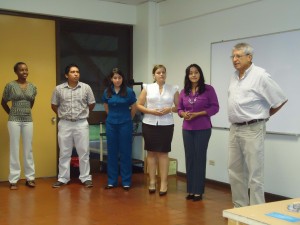Students hope to revive cacao at EARTH and in the region through entrepreneurial project
Monilia you came to stay
And now you bring me some hungry belly
You say you going nowhere
Till you bring me down to poverty
——-Walter Ferguson————
With the exception of bananas, perhaps no other crop has shaped the history and people of Costa Rica’s Limón province like cacao. Cacao production has played an essential role in Limon’s commercial activity since the XIX century; and during pre- and post-Columbian eras was considered “the fruit of the gods” by Bribrí indigenous peoples native to Costa Rica’s Caribbean coast and Talamanca mountain range.
Despite this crop’s cultural and economic importance for the country’s Caribbean region, cacao production declined significantly during the 1980’s. At the end of the ‘70s, the country had 8,000 hectares of cacao in production and an estimated harvest of more than 10,000 tons. By 2007, however, only 3,601 hectares were dedicated to cacao production.
 One of the causes of this decline was the fungus commonly known as Monilia (Moniliophthora roreri), which attacks cacao plantations. During the ‘80s, Monilia destroyed the majority of Limón’s cacao plantations. Because of the damage, farmers had no choice but to change business or sell their land.
One of the causes of this decline was the fungus commonly known as Monilia (Moniliophthora roreri), which attacks cacao plantations. During the ‘80s, Monilia destroyed the majority of Limón’s cacao plantations. Because of the damage, farmers had no choice but to change business or sell their land.
In 2011, as part of the Jorge Manuel Dengo O. Entrepreneurial Projects Program, a group of students comprised of France Gina Beauzil (‘14, Haiti), Carlos Francisco Canul (‘14, Mexico), Alejandra Díaz (‘14, Guatemala), Beatriz Elizondo (‘14, Costa Rica) and Marcela Gutiérrez (14, Colombia) began analyzing the lack of cacao on campus. Motivated by the history of cacao and Monilia in the region and the presence of students from cacao-producing countries in the Americas and Africa, they developed a unique proposal for their entrepreneurial project.
They proposed setting up a business (later named Agrocacao. E.A.T) to establish a cacao plantation for academic and research purposes at EARTH. The business aimed to establish organic production systems with six improved cacao varieties, resistant to diseases such as Monilia.
“We are planting six cacao varieties, because it’s a project of academic interest; we want to learn about these six varieties and find out the production differences for each variety. Within two or three years, professors and student will be able to use the plantation for research and courses,” said student Alejandra Díaz, General Manager of Agrocacao. E.A.T.
It was not easy to convince the University that of the business idea’s profitability. But after several rejections, revisions, extensive research and a lot of effort, the Entrepreneurial Project Program committee approved the Agroforestry System project for Cacao (Theobroma cacao L.).
Now, the five dedicated Agrocacao. E.A.T members are working hard to plant and maintain the two-hectare project located within EARTH’s Integrated Organic Farm. Diversification plays an important role in the project, as they are planting bananas and forestry species within the cacao plantation as a model for small- and medium-scale organic farmers to generate short-term, mid-term and long-term income streams.
Professor Luís Pocasangre, EARTH’s research coordinator and advisor to Agrocacao. E.A.T, stresses the importance of the project: “For me, the greatest value of this project is that it will provide us with the genetic material needed to do research. This is particularly important for the African community, as Africa is the biggest cacao-producing continent, and our African students are interested in researching this crop. Also, historically this was a cacao-producing region, and today there’s almost no cacao because of the Monilia. They [Agrocacao E.A.T] are bringing back something that grows here naturally.”




